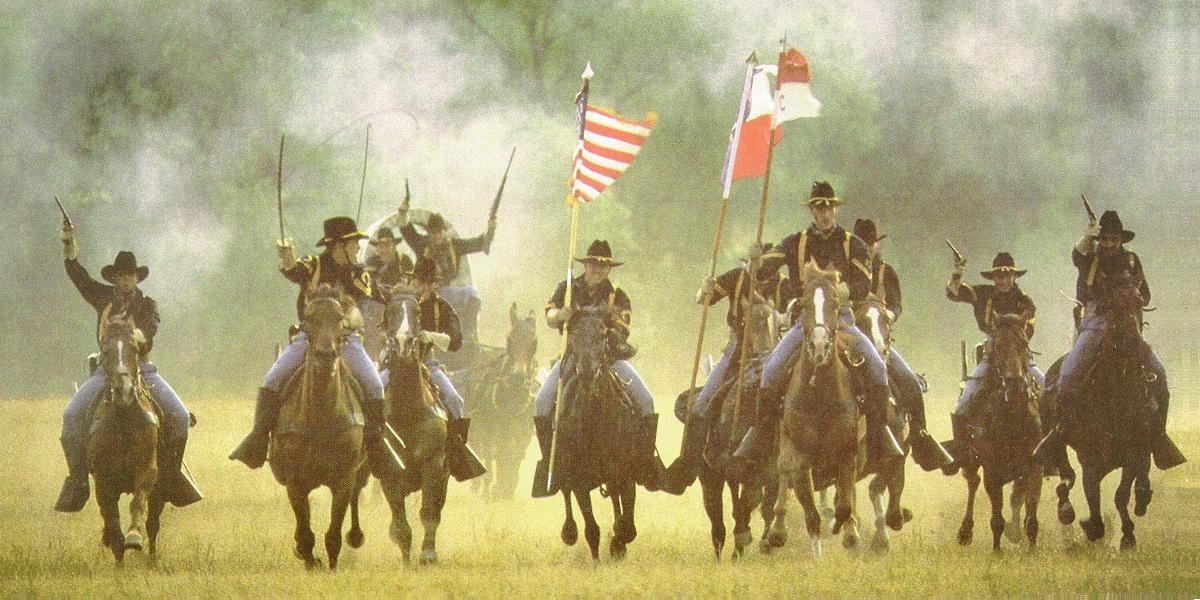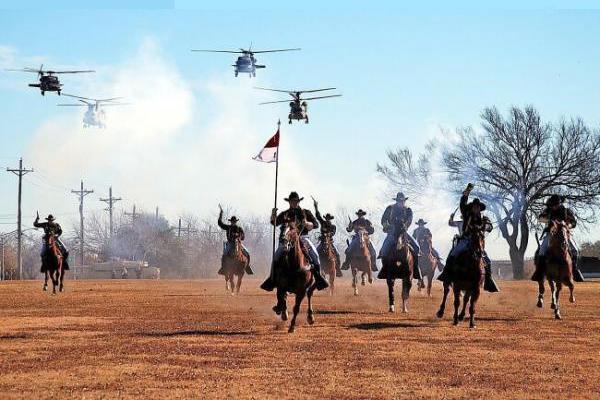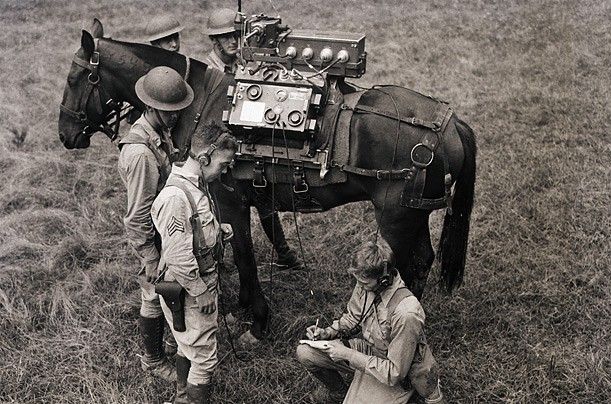
Developments made in US Cavalry during the Interwar Years featured a marked increase in emphasis on the use of terrain and maneuver to exploit the mobility of horses, with an almost parallel emphasis placed on dispersion to reduce vulnerability. 

By the late 1930s, we were also experimenting with a concept known as “portée cavalry” which used trucks to move the horses and riders over long distances via roads, adding a potentially more strategic mobility aspect to horse cav. 



“Mounted charges remained a part of cavalry doctrine but not the dominant expression of the mounted arm in combat.”
Horses “became a battlefield taxi rather than a combat platform” – it cannot be overstated how strongly some horse cav officers resisted changes that would take away their horses👀 

Despite this, there was an interest in using tanks and motor vehicles in traditional cavalry-style missions so there was some willingness to experiment but there were obstacles beyond intra-branch resistance.
The National Defense Act of 1920 established guidelines for how the Army could be organized and how it would function throughout the Interwar Years. 

“Section 17 assigned exclusive responsibility for tank development, including tactics and organization, to the Infantry.”
The best Cavalry could do at the time was explore possibilities in the realm of armored cars.
@1stCavalryDiv was used as a sort of testbed for experimentation with cars and other vehicles. They got a small number of armored cars that they used to develop tactics, techniques, and procedures (TTPs) for the use of armored cars in recon and security missions. 

Even though there was limited funding during the Interwar Years, we did have Army exercises and some were Cavalry-specific. In the 1929 Maneuvers, @1stCavalryDiv attached armored cars to one of their cavalry regiments. 

The cars were used about 10 miles ahead of the regiment, sending information and tactical developments back to the regiment by use of radio.
Armored cars demonstrated value in information-gathering missions, but their use in these exercises triggered ideas for possibly using them in anti-tank operations and other activities.
@1stCavalryDiv continued to use armored cars in exercises, stressing the value of radios for coordinating operations, and formulating principles that would guide their future use.
At the same time, parallel efforts were being made at the Cavalry School which was located at @FortRiley in Kansas. @MastersManeuver @ArmorSchool @CavalryCourse 

The 1st Cavalry Regiment was among the first to replace horses with a diverse range of motor vehicles, effectively becoming the 1st Cavalry Regiment (Mechanized). In 1933, they moved from Texas to @FortKnoxKY 

Working with other newly mechanized units, efforts were made at Fort Knox to determine the optimal organization structure, doctrine, and materiel for mechanized cavalry units. 

They developed new reconnaissance doctrine for these mechanized cav units and found that 10 vehicles was the “ideal” for a troop that could “routinely operate forward of the parent organization and report on tactical and terrain conditions.”
By contrast, seven was found to be the ideal number of vehicles for a scout car troop. (Don't get attached to these numbers 😂)
Together, the armored car troop of 10 and the scout car troop of 7 formed a “covering squadron” that would take on the responsibility of conducting reconnaissance and security missions.
“The armored car troop would seek out hostile forces, then maintain contact and observe hostile activity until the regiment’s combat elements arrived. Then the armored car troop would transition to flank security while the regiment attacked” before resuming its recon function.
Similar determinations were being made at the same time by the @1stCavalryDiv regarding the use of armored cars for cavalry operations.
By the 1934 Maneuvers, scout car platoons were attached to horse cavalry squadrons for use in reconnaissance missions and to track mechanized enemy forces. 

Armored cars and scout cars would perform different functions. The armored cars could move far ahead of the regiment while the scout cars would stay just ahead of the main body. This makes sense considering the scout cars were not protected in the same way.
Scout cars were open-top lightly armored vehicles with machine guns, so clearly not designed to go one-on-one against armored vehicles and tanks. 

The scout car was a “wheeled fighting vehicle designed for reconnaissance and limited defensive action, high road speed, fair cross-country mobility, heavy flexible firepower, and limited armor protection.” 

The armored car was “similar to the scout car, operates at greater distance from supporting troops, [and is] more effectively armored.” 





Armored cars were used to support the cavalry division, while the regiment would benefit from an assignment of scout cars.
“The distinct qualities of each car and their intended allotment reflected the reconnaissance needs of different command echelons.”
The Cavalry School thought that scout cars would become a permanent thing in cavalry regiments for recon missions with potential to augment these units for anti-tank capabilities. But Doctrine disagreed.
Doctrinal guidance “discouraged commitment to battle or other actions that diverted the scout car from its primary role – information gathering.”
“The sole purpose of the reconnaissance vehicle with horse cavalry is to gather information by observation. Its use for combat will be accidental, emergency, or self-protective. It is employed in small groups which are enjoyed to avoid fighting.”
During the 1934 Maneuvers at the Cavalry School in Kansas, scout cars provided additional radio support and served as radio relay stations. This function became an acceptable role for these vehicles even though it essentially diverted them from their primary recon missions.
This role was officially demonstrated by the 6th Cavalry in 1936 – these guys eventually became a selection of our modern Air Cav units @16thCAB @doctrinatrix_C2 @KRB_58 

“Subsequently, scout cars found themselves employed in similar activities, and regimental command and control became identified in horse cavalry doctrine as an acceptable secondary mission.” 

By 1936, both the Cavalry School at @FortRiley and the @1stCavalryDiv were fully embracing armored cars in their cavalry training and operations.
The lessons learned from the 1934 Maneuvers led to armored car troops expanding and the use of a covering squadron changing by 1936.
The 1936 Maneuvers served as a field test for the new armored car troop which would have 17 cars organized into four platoons (4 cars each) and a troop headquarters with an armored car and a passenger car for command and control (C2) functions.
They also got 3 trucks for maintenance and supplies, and 5 motorcycles for coolness…
I’m kidding. The motorcycles were attached to the platoons to provide detailed recon support at select points. 

“The replacement of scout cars with armored cars simplified supply and maintenance concerns. Tactically, the new troop organization eased command and control and provided greater flexibility of employment.”
“It also ensured that the primary reconnaissance platforms possessed the same level of armored protection.”
In the 1936 Maneuvers, armored cars were used to locate and (if possible) destroy anti-tank weapons since these posed a significant threat to the regiment’s ability to maneuver and thus posed a threat to its operational tempo.
“… the aggressive nature and rapid pace of the armored cars also triggered repeated contact with enemy forces and correspondingly high loss rate. In the worst case, the troop lost half its strength in a single exercise scenario.”
We were starting to see the link between effective reconnaissance and the ability to influence the battlefield / fight by the late 1930s.
Mechanization of the Cavalry expanded to include the 13th Cav Regiment (Mechanized), which got an attachment of 68th Field Artillery (Mechanized). The 68th FA was tasked with developing artillery techniques best suited for mechanized units. 

Together with the 1st Cavalry Regiment (Mechanized), these units formed the 7th Cavalry Brigade (Mechanized) which was the @USArmy's only combined arms unit in the 1930s. @usacactraining @MCTP_OGBravo @MCTP_OGCharlie @MastersManeuver
Horse cavalry units with scout cars would be tasked with supporting C2 functions, providing courier services, and acting as radio relay stations, but many of the mechanized cavalry leadership felt this was a counterproductive effort.
That 7th Cavalry Brigade decided to use aircraft for reconnaissance to guide ground movements during the 1938 Maneuvers. During part of the exercise, the brigade faced an infantry brigade that was using “innovative antitank tactics.”
The combination of aircraft and armored cars moving ahead of the mechanized cavalry columns kept a steady flow of information to brigade leadership, identifying and reporting on hostile troop locations and movement.
“The simulated battle ended with the mechanized cavalry poised to strike the rear of the infantry brigade despite the latter’s antitank measures, which received Army-wide acclaim.” 

Radio communications had proven vital to success. Radio offered the fastest transmission of data over a distance during the Interwar Years. But mechanized cavalry’s reliance on radio was not universally welcome to the Army at the time.
Many still questioned the reliability of radio equipment and there were concerns over potential interception of radio transmissions leading much of the Army to remain somewhat conservative on radio use. 

Mechanized cavalry had the same concerns but addressed OPSEC through “the adoption of command procedures that did not mandate sending details of unit activities over the airwaves.”
Despite these efforts, the 7th Cavalry Brigade still received a significant amount of criticism for what many in the Army saw as “excessive radio use” in the 1937 and 1938 exercises.
The 1938 Cavalry Field Manual, Volume 1 governed the full range of cav missions and incorporated lessons learned during the Interwar Years – this is a decent example of how training, exercises, and other developments inform doctrine. @doctrinatrix_C2 @USArmyCALL
This new manual “provided detailed guidance on conducting reconnaissance from individual scouts to entire units, including scout car platoons.”
Horse-mounted scouts were to “avoid detection and hostile forces whenever possible” and “make use of terrain and inclement weather.” 

Dismounted movement and observation were now considered “normal activities” especially in rugged, heavily wooded, and urban terrain. 

“The entire focus of reconnaissance effort lay in the timely receipt of information to the unit commander. Hence, the timeline for the reconnaissance mission hinged on when the commander required the objective information.”
Careful recon “necessitated slow movement and frequent dismounted observation.” This method provided the most detailed info but was the most time consuming.
When faster results were necessary, the scout cars could perform mounted recon, moving quickly until they encountered the enemy and employing recon by fire against suspected enemy positions. @CavRTK @MastersManeuver @CavalryCourse
Mounted recon increased the risk of unexpected contact. If ambushed, scout cars were to “… go around an obstacle, mission permitting, rather than to engage in a prolonged fire fight or risk an unfavorable outcome.”
If they could not avoid fighting, the scout cars were to “employ basic fire and maneuver principles, fighting dismounted if that increased the likelihood of success.”
Scout car platoons would get secondary missions under the updated doctrine that included “security, antitank, command support, seizure of distant objectives, harassment, and delay.”
Remember that National Defense Act of 1920 changing things? Well, that NDA put the primary responsibility of tank development in the hands of the Infantry Branch. For this reason, the lines between the remaining Branch threads are going to be a little blurry at times.
If you're just tuning in or you've missed any of the previous threads, you can find them all saved on this account under ⚡️Moments or with this direct link twitter.com/i/events/13642…
• • •
Missing some Tweet in this thread? You can try to
force a refresh






















